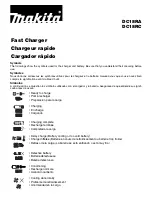
5
AUTOMATIC CHARGING AND BATTERY STATUS MONITORING:
Battery Tender® battery chargers are completely automatic and may be left
connected to both AC power and to the battery that it is charging for long
periods of time. The charger output power, voltage, and current depends on
the condition of the battery it is charging. Battery Tender
®
battery chargers
have several status LED indicators that provide a visual means to determine
the operating mode of the charger and hence the condition of the battery
connected to the charger.
When AC power is first applied to the charger all LEDs will illuminate for
two to three seconds.
The
Charging Status/Error Light Ring
shows whether the charger is
operating in one of the four primary charge modes:
1)
Qualification/Initialization mode:
The Monitor Circuit verifies
appropriate battery voltage levels and good electrical continuity
between the battery and the charger DC output.
2)
Bulk mode
(full charge, constant current, battery is 0% to 80%
charged)
3)
Absorption mode
(high constant voltage, battery is 80% to 100%
charged).
4)
Storage/float maintenance
mode
(low constant voltage, battery is
100% to 103% charged).
When the battery is fully charged, the
Charger Status Light Ring
will turn
solid green and the charger will switch to a storage/float maintenance
charge mode. The Battery Tender
®
battery charger will automatically
monitor and maintain the battery at full charge.
CHARGE RATE SELECTION BUTTON
The Battery Tender
®
battery charger has a “Charge Rate” selection button
which allows you to switch between charging at a rate of 2 Amps or
8 Amps.
The LED next to selected Amperage rate will illuminate green.
The charge rate can be selected once the charger has AC power applied
and before the charger is connected to the battery.
Once the charger has AC power and is also connected to the battery the
charge rate selection cannot be changed. To change the mode, disconnect
the battery from the charger.
If the AC power is interrupted the charger will resume charging at the last
charge rate setting used.
6
BATTERY TYPE SELECTION BUTTON
The Battery Tender
®
battery charger has a “Battery Type selection button
which allows you to switch between charging a 12 Volt Standard (Lead
Acid) battery, a 12Volt AGM (Sealed) battery and a 12Volt Lithium Iron
Phosphate (LiFePO4) battery. DO NOT USE THIS CHARGER TO
CHARGE ANY OTHER TYPE OF BATTERY.
The battery type can be selected once the charger has AC power applied
and before the charger is connected to the battery.
Once the charger has AC power and is also connected to the battery the
battery type cannot be changed. To change the battery type, disconnect
the battery from the charger.
If the AC power is interrupted the charger will resume charging using the
last setting.
ATTENTION: The Battery Tender
®
CHARGER HAS A SPARK FREE
CIRCUITRY.
The output alligator clips or ring terminals will not spark when
they are touched together. The Battery Tender
®
battery charger will not
produce an output voltage until it senses at least 3 volts from the battery. It
must be connected to a battery with the correct polarity before it will start
charging a battery. Therefore, if you plug the AC power cord into an AC
power outlet, and if the output alligator clips or ring terminals are not
connected to a battery, and if you touch the alligator clips or ring terminals
together, there will be no electrical spark.
NOTE:
THE OUTPUT CLIPS OR RING TERMINALS MUST BE CONNECTED TO
A BATTERY BEFORE THE CHARGER CAN PRODUCE AN OUTPUT
VOLTAGE.
TIME REQUIRED TO CHARGE A BATTERY:
The Battery Tender
®
battery charger charges at a rate of 2.0 Amps or 2.0
Amp-hours per hour. Therefore, a fully discharged 15 Amp-Hour battery will
take approximately 6 hours to recharge to 80% capacity.
The Battery Tender
®
battery charger charges at a rate of 8.0 Amps or 8.0
Amp-hours per hour. Therefore, a fully discharged 15 Amp-Hour battery will
take approximately 1.5 hours to recharge to 80% capacity.























